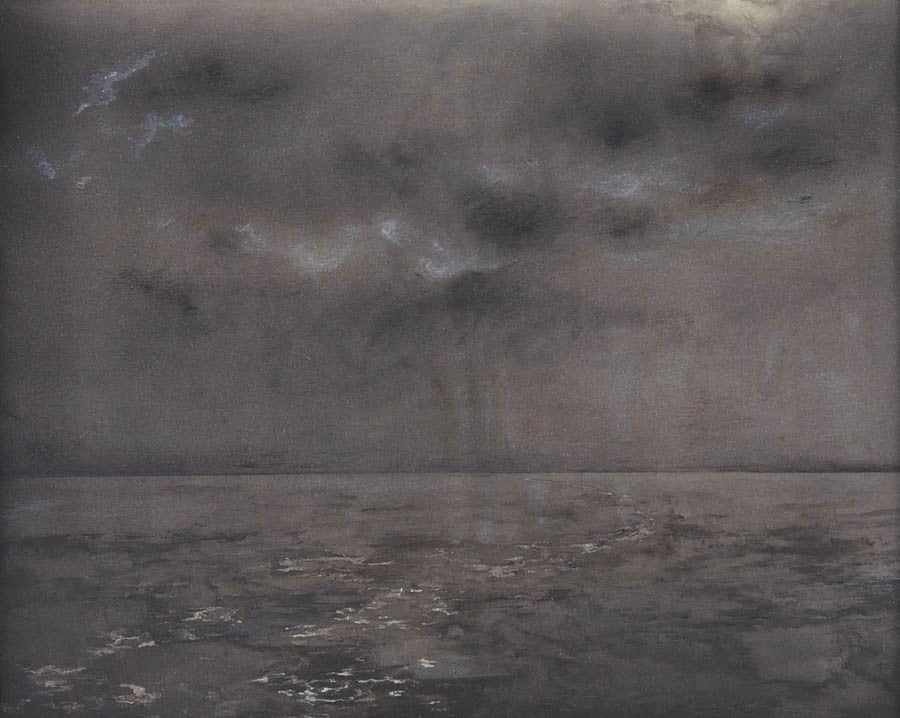
A small posthumous retrospective provided a unique opportunity to glimpse the artworks of Lala Rukh

Designing posters of women’s resistance against the worst military dictatorship and producing minimal renderings of human figures, landscapes and city skyline may appear a contradictory practice to some on the part of an artist. But not in the case of Lala Rukh (1948-2017), in whom both merge to a point where an artist’s self is revealed in diverse expressions of the creative self.
If one were to describe it in one word, the art of Lala Rukh is about defiance; but not in the predictable, prescribed or popular sense. She questioned all kinds of constructs -- of politics, morality and taste. During General Zia ul Haq’s oppressive rule, Lala Rukh joined several women activists and artists, and also men, who came out of their studios, living and work places, and protested and fought for women’s rights. It was a struggle to maintain a just equilibrium within society, where humans were not discriminated on the basis of the gender they were born into.
As conscientious individuals, they resisted the draconian decrees, actions and attitudes against women, through their works, words and acts. In fact, it can be safely said that women were the most vocal and visible group to have struggled for democracy.
Lala Rukh was their leading light, both as a member of civil society and an artist. During the National Exhibition held at Alhamra Art Centre Lahore in 1983, a number of women artists drafted ‘Women Artists’ Manifesto’. In this 7-point document, signed by fifteen female artists including Lala Rukh, they "identified their work with the political struggle for female emancipation, employing it to criticize the government’s policies and subvert traditional attitudes".
It was at the same venue where the Manifesto was drafted that one was able to see the works of Lala Rukh from Nov 6-8, 2017. This small posthumous retrospective provided a unique opportunity to glimpse the works that have recently been a part of various important exhibitions such as Documenta and at other locations in the world. The Alhamra exhibition was significant for another reason -- the 17 works on display documented and described the creative life of the artist, particularly from 1979 to 2017. Another relevant section of the show was posters (of ‘Women’s Action Forum: National’, and ‘Simurgh’) made by Lala Rukh. These were produced to spread awareness of women’s status and rights, and related directly to an audience which was not necessarily trained in art but certainly had an aesthetic sense. The imagery in these posters, which are now rightfully considered ‘artworks’ (especially after Documenta, 2017), was chosen to communicate with masses, yet the artist’s ability to create a visual that can match any other ‘conventional’ art piece is remarkable.
Besides meeting their function, these posters challenged the notion of high art. Boundaries between art and something as functional as a poster or any other piece of design are a late, superficial and mistaken concept. All artworks (prior to Modernism) which adorn the books of art history were manufactured for a purpose, and were tools to transmit a certain message, meaning or text to the larger audience. Many of those were paintings on cave walls from Prehistory, frescos of Egyptian period, Greek vases, Roman portraits, Christian mosaics, Islamic calligraphy, Buddhist sculptures, African statues, Aztec reliefs or Chines scrolls. Nothing was made without a function or purely for decoration.
In her minimal rendering of human models from early 1980s to the later drawings and mixed media works, as well as animation (Rupak, 2017), Lala Rukh opted for a language that apparently is not about any political message or content. Brief and disconnected, yet sensitive outlines of human figures in graphite, tiny marks defining a horizon line in pencil, an Urdu verse written in black small letters in the middle of page or square-like dot (originating from Urdu script, which comprise the main content/visual in her animation) all indicate that the artist was seeking to express a personal, private and poetic realm. She even made use of some lines of Faiz Ahmed Faiz but, by and large, the work is about invoking a sensation that can only be felt and not described. In that sense, these works may be equated with music.
"Lala Rukh’s father, Hayat Ahmed Khan, was himself involved in the promotion of music in the fifties and sixties…All his daughters were encouraged to follow their artistic inclinations…" (Unveiling the Visible, Salima Hashmi). Thus, her work can be presented as a parallel to music. Particularly her digital prints (Sand Drawing: 2, 2000), mixed media (River in an Ocean, 1992) and serigraph and pastels (Sigiriya; Dusk; Dawn; Sunset -- all from 1983-1989) convey a highly lyrical imagery that can be felt than described or denoted.
Interestingly, a person who spent most of her life as an activist and fought for women’s rights in every form and on all forums does not opt for the same pictorial/political solutions in these works. Lala Rukh’s art confirms her revolutionary position in a different scheme. Because against all odds and expectations, she maintained her art practice as a personal pursuit. Even in a period that was marred by Zia’s dictatorship, she did not come up with ‘expected’ formats and formulae in her artworks.
Just like state censorship, there is societal scrutiny that forces an individual to act in a certain manner -- for the good of society’s greater causes. But Lala Rukh resisted this temptation despite the pressure from outside. Even now, long after Zia’s demise, censorship has seeped into our selves, curbing every expression, comment and joke. It is altering our behaviour, art production, freedom of speech, right to reflect, forcing us all to adopt a certain and strict code of conduct.
Lala Rukh’s example teaches us that art is beyond these limitations, whether imposed by junta, politically correct crowd or self-righteous individuals in art, literature or any field of life.